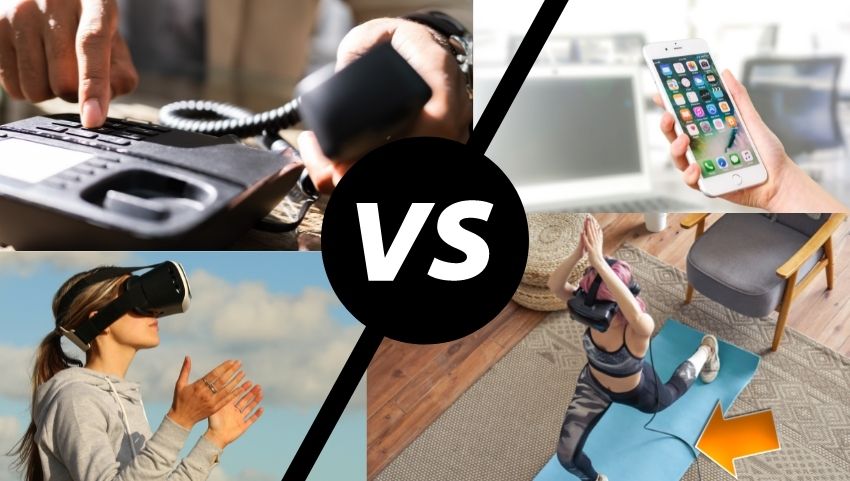A standalone VR headset (like the Quest 2) can fully operate without the assistance of any external peripherals. A PC VR headset, needs to be connected (usually via a wire) to a PC in order to play VR games (usually via Steam).
Is a Standalone Headset better Than a PC VR Headset?
Quite frankly yes standalone is better than PC VR in almost every conceivable way.
Now my friends in the VR community are going to be mad about that hot take for reasons I’ll get to in a moment. But, this is basically like asking if a smartphone is better than a landline telephone. Yes it is, and the reasons its better are basically the same (no wires).

A standalone VR headset comes equipped with its own powerful mobile processor (CPU) so that it doesn’t need to be wired to your PC to do the graphics processing. And in my opinion, those lack of wires connecting you to a very expensive gaming PC make the standalone experience much more fun, immersive, and satisfying.
What hardcore VR enthusiasts would point out as a counterpoint is that a gaming PC can do more hardcore graphics processing and thus provide a better visual experience in the headset.
And they’re not wrong. But, I see that as a temporary thing caused by the pandemic fueled chip shortage in 2020. Companies like Apple have chips that rival gaming PC’s that would fit in a VR headset. Plus, computers get faster every year. Wait a few years and this won’t be a thing anymore.
However, there is one major advantage PC VR currently has over standalone VR.
More Games Are Currently Available with PC VR via Steam
I see this as temporary and devices like the Quest 2 can also play PC VR games when connected to your PC via an overly expensive link cable (Windows, not a Mac). So it’s not like you should avoid getting a standalone headset to play PC VR games either.

That said, headsets like the Varjo Aero and Reverb G2 are visually superior to the Quest 2 when playing PC VR games (particularly the Aero). So if you plan to buy a headset and then spend all of your time playing Microsoft flight simulator, then you can make a valid case that a PC VR headset is better for you.
But, wanting to play Steam games with a higher field of view / higher resolution headset is currently the only reason I could see buying a PC VR headset over a standalone one right now. And even that narrative kind-of falls apart unless you’re talking about the $2,000+ Varjo Aero. Because most PC VR headsets out there don’t have the resolution of even the Quest 2.
Which VR Headsets Are Standalone vs. PC VR
I have an entire article dedicated to the best VR Headsets on the market right now (and in the future).
As of today it’s basically the Quest 2 and the Pico Neo 3 Link that offer a standalone version. The rest are PC VR.
| Year Released | Headset | Standalone or PC VR |
| 2016 | HTC VIVE | PC VR |
| 2020 | STARVR ONE | PC VR |
| 2016 | Oculus Rift CV1 | PC VR |
| 2020 | Pimax Artisan | PC VR |
| 2019 | Valve Index | PC VR |
| 2020 | HTC Vive Pro | PC VR |
| 2019 | Oculus Rift S | PC VR |
| 2020 | Oculus Quest 2 | Both |
| 2020 | HP Reverb G2 V2 | PC VR |
| 2021 | Varjo Aero | PC VR |
| 2022 | Pico Neo Link 3 | Both |
| ???? | Cambria, Pimax 12k, Apple Headset, etc | Both |
As you can see, the latest headsets are starting to get released as both standalone and PC VR devices. PC VR enthusiasts who hate on standalone are basically the equivalent to people who got involved in console wars over the past decade. You just want to be able to say the device you bought was the best.
But it’s not. We’re in an age of rapidly advancing VR technology. The newest devices are always going to be the best (the ones released in the past year or so). And the newest devices have ditched PC VR exclusivity for the more widely popular standalone experiences.


